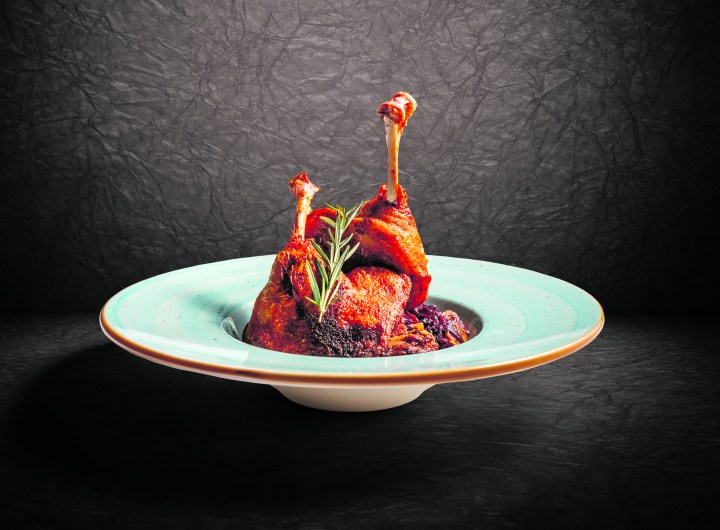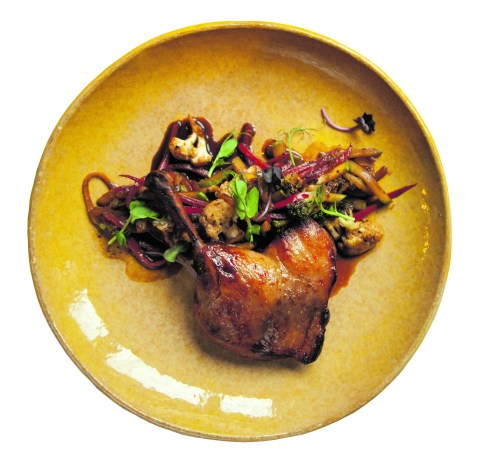SLOW & CRISP
Throwback Thursday: The art of confit duck

A confit duck leg crisped in its own fat and served in all its grand simplicity belies the time and patience that has gone into its preparation.
In the Gascony and Basque region of south-western France, people with good palates and time on their hands gave us something very special. They found a way to preserve the meat of geese, ducks and pigs for as long as six months: The art of confit. But it’s the confit duck beloved by all of France and much of the world that is their most lasting gift.
To imagine what it must have been like to taste the meat of confit duck leg and wing for the first time, make it yourself, real long and slow, and then leave it to cool. Then, before going to bed for the night, sneak into the kitchen and lift the lid. I made confit duck legs and wings this week (don’t leave the wings out, they’re a treat, you’ll see), and that is what I did. Snuck into the kitchen. Pulled away a piece of the wing meat and popped it in my mouth. Oh! My! Gaaahd! I yelled to the rest of the sleeping house in my best impersonation of Chandler’s ex-girlfriend on Friends. It was Just. So. Ridiculously. Yum.
Once upon a time, a Basquaise farmer must have started cooking the dissected quarters of a goose or duck, skin, fat and all, in a pot and forgotten about it. Hours later he would have awakened from his slumber with something unfamiliar but compelling in his nostrils. Wrapping his nightgown around him against the cold, he would have followed his nose to the kitchen range and the pot suspended over the few remaining fading embers. Lifting the lid, he must have swooned, and picked up a ladle, and then put it down again and reached in with his fingers, and pulled away a strip of that tender meat. Mon Dieu! He must have exclaimed. Ma Chérie! Viens ici! Goûte ça! My darling, come here, taste this! And confit duck was born.
In fact, it was more likely to have been goose. Even pork. These were the meats preserved in their own fat over many long hours to create one of the most important ways of keeping meat that is edible long after the animal’s slaughter. But it is confit duck that has truly stood the test of time and of geography. It travelled throughout France and out into the greater world.
The word confit only means to preserve. So you can preserve anything in fat, or in a syrup (of sugar and water), as long as it is done very slowly and at a very low heat. So there is fruit or vegetable confit too. But here we’re talking about birds.
Other than the temperature it would be frying. Add high heat to fat and you’re frying, whether shallow or deep. But apply hardly any fire at all with the meat covered by the fat, and slowly, inexorably, allow it to steep in that warm and soothing medium, and you’ll end up with something far finer than it was in its raw form only hours earlier. And that’s confit.
Today, you’ll find confit duck legs on bistro menus throughout France. The joy of confit duck legs is that everything, including that skin, has been cooked to utter perfection. Weeks or even months later you can heat a dry frying pan or skillet, lift a leg out of its fat, lay it on the hot pan and let the sizzle crisp up that skin. Just that fat that remains on it after you shake it off over the container it has mellowed in for all that time is all you need. And that is the beginning and end of the recipe. You can prepare any vegetables or sauce first and have them ready and hot; the frying of the duck itself takes only minutes. Yet its impact on the palate is immeasurable. There’s also no need to discard the fat from your confit once you’ve finally eaten the meat. Scoop it out and into a pan for frying eggs, or sautéing vegetables. Best of all, use confit fat for roasting potatoes, or steam potato scallops and then pan-fry them until golden and crisp in confit fat.
There are two processes in making confit duck: salt curing, followed by the confit itself. The salt rub can contain other things: garlic, herbs (I used thyme), or even spices or citrus zest for that matter though they would not be traditional. This salt mixture is rubbed into the skin and flesh of (clean and dry) duck portions which are then refrigerated for at least six hours; Wikipedia says up to 36. I’d call it a day, or overnight. That’s all you need.
This is then rinsed off, the joints dried again, and they’re laid in a pot to render their own fat. I prick the skin very many times first to aid the process of the fats being drawn out by the heat. I also add fat.
To this end, in a sense it’s worth starting planning for confit duck long before you make it. Even more than six months ago… which is what I did…
How to cook confit duck

Confit duck leg, Pak Choi with steamed vegetables. (Photo: iStock)
First, mix together 2 tsp salt with the leaves of 4 thyme sprigs. Rub this well into the fat and meat of the duck portions. Put them in the fridge, covered, for 6 hours or overnight.
The story of the fat for this confit started last July (2021) when I cooked rooibos tea-smoked marinated duck (as one does) and stored the remaining fat in a bakkie in the freezer labelled “Duck fat June 2021”. This is a habit worth getting into. You can never have too many hats, gloves and shoes, as Patsy taught us … or too much duck fat.
So out of the freezer that came this week and into the pot it went first. The pot was my old cast-iron casserole, very Karoo farmhouse, heavy-based and with a tight-fitting lid. Implements are important with this sort of cooking. Have a dig around in the cupboards and choose what’s most suitable.
But I had started with a whole duck, and it helps to do so as it gives you much more fat, and fat is what you need. I began by first trimming off the two wings, then cutting away the two leg and thigh quarters. Then I carefully cut out two neat breasts. These were to be that evening’s supper.
This leaves you with a carcass that has lots of fatty bits. Cut off every bit of fat and attached skin that you can find and keep it to help make a greater quantity of duck fat.
All of the bits and pieces of fat and skin etc, including the Parson’s Nose, went into the pot with the formerly frozen fat with a little heat under it to help ensure there’d be as much fat as possible for the task ahead.
Before the legs and wings went in, they needed to be rinsed of the salt solution and patted dry. Then, in they go. Larousse Gastronomique explains that “the leg (thigh) is considered the most succulent part of preserved poultry and the wing the tenderest”. In fact, goose was more often preserved in this way, though turkey and pork were (are) used too.
Bear in mind that, once heat is applied, the legs and thighs themselves will begin to give up their own fat. Your goal is to have enough fat for them to be immersed totally in it.
While the duck is rendering very slowly in the fat in the pot on the stove (don’t let it boil), preheat the oven to its very lowest heat, as low as 120℃. Cover the pot and pop it in. Leave it to cook at that almost imperceptible temperature for three or four hours. Then take it out and leave it to cool. Covered, on the stove top. With everything switched off. Go and have a couple of whiskies or watch a movie. Wait until the house is asleep, then sneak into the kitchen. You know what to do. But put the rest in the fridge. DM/TGIFood
Follow Tony Jackman on Instagram @tony_jackman_cooks.





 Become an Insider
Become an Insider
I’m a real “boerie on the braai” kind of cook. Now I’m going to have to go and find a clucking Duck! Yours, Elmer Fudd.
Even when I can get hold of canned confit of duck I’m a happy chap!